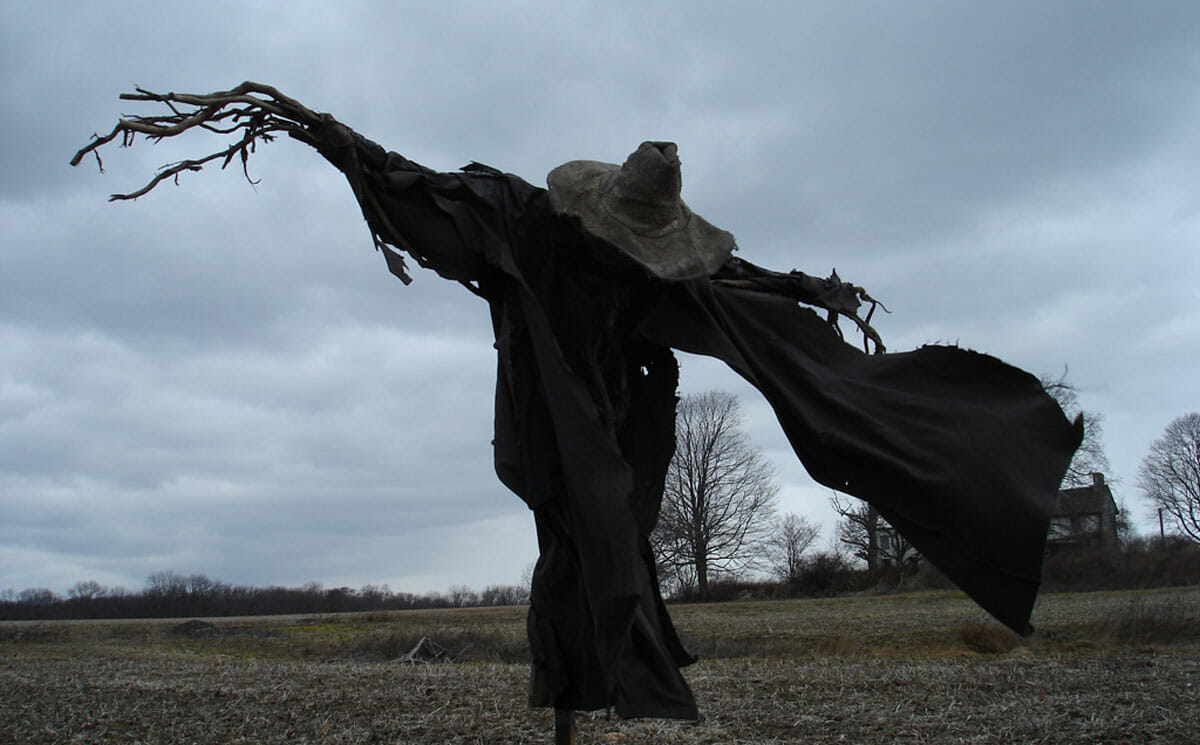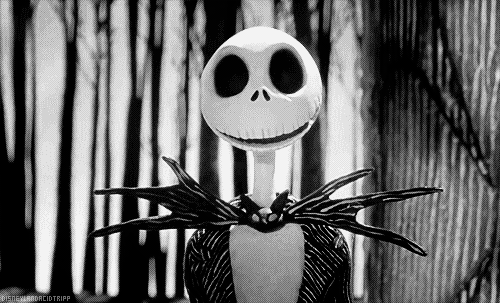 |
| Tim Burton's Sleepy Hollow, Paramount Pictures 1999 |
The Scarecrow is a global figure tied to nearly every culture, it stands out historically as an image synonymous with agriculture and harvest. There has never been a comprehensive study on the history of these figures, although the mere image can be viewed and examined anthropologically as their presence has been known to society for quite sometime. Some of the earliest Scarecrows are known to have been placed along the Nile River by ancient Egyptians most distinctively to ward off flocks of quail, who were considered a major pest to crop fields. Ancient Greece had a festival for
Priapus, the son of the god
Dionysus and and goddess
Aphrodite. Priapus was honored as the guardian of vegetation, gardens and livestock, a symbol for health and fertility mostly honored in gardens and homes. Wooden figures of Priapus were built and placed among crops as guardians of agriculture. He was painted purple with a club in one hand to scare the birds and a sickle in the other as a symbol for hopeful harvest.
 |
| 18th Century Icelandic Manuscript |
Ancient images of the Norse god Odin with his two ravens Huginn and Muninn are thought to be early inspirations for the Scarecrow. In Germany Scarecrows were crafted into witches whose flailing arms cast curses against those who dared to invade their territory. Early German immigrants who settled in Pennsylvania in the 1800's were among the first to tie red handkerchiefs to their mannequins in an effort to humanize them, they called them "Bootzamon" whose english translation is Bogeyman. Bogey stems from Bogie which in ancient folklore is name given to one of the most mischievous and frightening creatures, whose sole delight is in the torment of mankind, this figure is attached to the Unseelie Court (a grouping of malevolent creatures/ faeries in Celtic lore. This is perhaps the birth of the popular dark figure of the bogeyman.)
 |
| Pumpkinrot.com |
Before stick men, children were labored in Medieval Europe to scare birds away from crops by clapping together large wooden sticks. After the Great Plague adults took the job, guarding their crops by hiding in straw-huts in a much similar fashion to the Native Americans. Much later when farms grew considerably larger this was the advent of the earliest effigies, who could stand guard a field without using man-power.
 |
| Arnaud de Vallois 2010 |
Known as perhaps the very first field 'gods' or guards is the Japanese "kakashi", representations of the Japanese deity Kuebiko (the Shinto kami/ god of knowledge and agriculture,) who is unable to walk yet holds all the wisdom of the world. The kakashi, very similar to ancient Greece's wooden Priapus, were crafted with old rags, bells and sticks. They would subsequently be mounted on poles then set on fire, the flames and the smell would keep birds and small animals away. The word kakashi literally translates to "something stinky". Some schools of thought believe that Japanese farmers would utilize the kakashi by attaching spoiled meats and vegetables, and this anthropologically might be the birth of the the image of a scarecrow with a pumpkin-head. There are many names for the scarecrow around the world: To the Scottish he is
Tattie Bogle, in Sommerset, England he is known as
Mommet. In Berkshire, Isle of Wight he called
Hodmedod which translates to "with hat and stick". In Bengali it is
kaktadua,
pugalo to Russia and
straska to the Czech's.
 |
| Etching by Jim Yarbrough |
Some occult thought tie the scarecrow to deeper historic symbolism. The scarecrow's soul purpose is to
frighten and it is nearly impossible to look upon the figure without noticing the cross. The cross is synonymous with Jesus Christ and was used by the likes of Vlad the Impaler who had a propensity for impaling and displaying his enemies to ward off others. Subsequently the scarecrow is also seen as a warning and a symbol for "no trespassing".
 |
| D.C. Comics |
Straw-men and Scarecrows are seen throughout classic and modern mythology. The Scarecrow also known as
Jonathan Crane in
D.C. Comics is one of Batman's most powerful and popular enemies.
Turnip-Head is a cursed Scarecrow who appears in both the film and the novel titled:
Howl's Moving Castle, in the novel he is just known as the Scarecrow. He is definitely an homage to kakashi. He is fashioned upon two cross-bound poles and has a withering turnip for a head. In the film Turnip-Head is revealed to be a prince who suffered an enchantment but is restored by the main character Sophie when his heart is placed back within his chest. This is not unlike the most famous Scarecrow from Oz.
 |
| Howl's Moving Castle, Distributed by Walt Disney Pictures 2004 |
It would be impossible to contemplate scarecrows and not draw your thoughts to Ray Bolger in the 1939 Classic film
The Wizard of Oz. This depiction of the
Scarecrow balances out the darker history that the figure once represented. The Scarecrow, along with the
Tin Man and the
Cowardly Lion are benevolent staples among the pages of fairy tales and children's minds.
 |
| Ray Bolger as the Scarecrow in The Wizard of Oz, MGM Pictures 1939 |
The irony behind the Scarecrow in the Wizard of Oz rests with it's creator
L. Frank Baum, who once stated that he had reoccurring nightmares as a child, in which he was being chased by a scarecrow. The development of the figure in his story was established to help him rearrange his fear and he unintentionally did this same for the rest of the world.
 |
| John R. Neill 1929 |
L. Frank Baum wrote into his second Oz novel titled:
The Marvelous Land of Oz a character named
Jack Pumpkinhead. Jack Pumpkinhead is a play on early European scarecrows who were known as Jack-of-straw. Jack is closer to a traditional scarecrow as he is crafted with wooden sticks and a large Jack-O-Lantern for a head. He was designed by a boy named Tip as a prank on the old witch Mombie. Jack Pumpkinhead becomes quite close to the Scarecrow and eventually a highly regarded citizen in the land of Oz.
 |
| Jack Pumpkinhead as seen in Disney's Return to Oz 1985 |
Jack Pumpkinhead is surely the inspiration for Tim Burton's
Jack in the 1993 film:
The Nightmare Before Christmas.
 |
| Tim Burton's The Nightmare Before Christmas, Touchstone Pictures 1993 |
Burton's Jack is the Pumpkin King and the leader of Halloween Town. Jack, in a way, represents the strong evolution of the scarecrow and and his perpetual ties to autumn and Halloween.
 |
| Tim Burton's The Nightmare Before Christmas, Touchstone Pictures 1993 |
Source Material:
- An Encyclopedia of Fairies, Katherine Briggs, Pantheon Books, New York, N. Y. 1976
- The Annotated Wizard of Oz, L. Frank Baum, Michael Patrick Hearn, W. W. Norton & Co Inc, 2000
- The Marvelous Land of Oz, L. Frank Baum, Dover Publications Inc. New York, N.Y. 1969
- wikipedia.com
- dicitonary.reference.com
- howlscastle.wikia.com
- paganwiccan.about.com
- pumpkinrot.com
- scarecrowland.co.uk/history
- modernfarmer.com












Great write up William. You go deep down the rabbit hole of history.
ReplyDelete